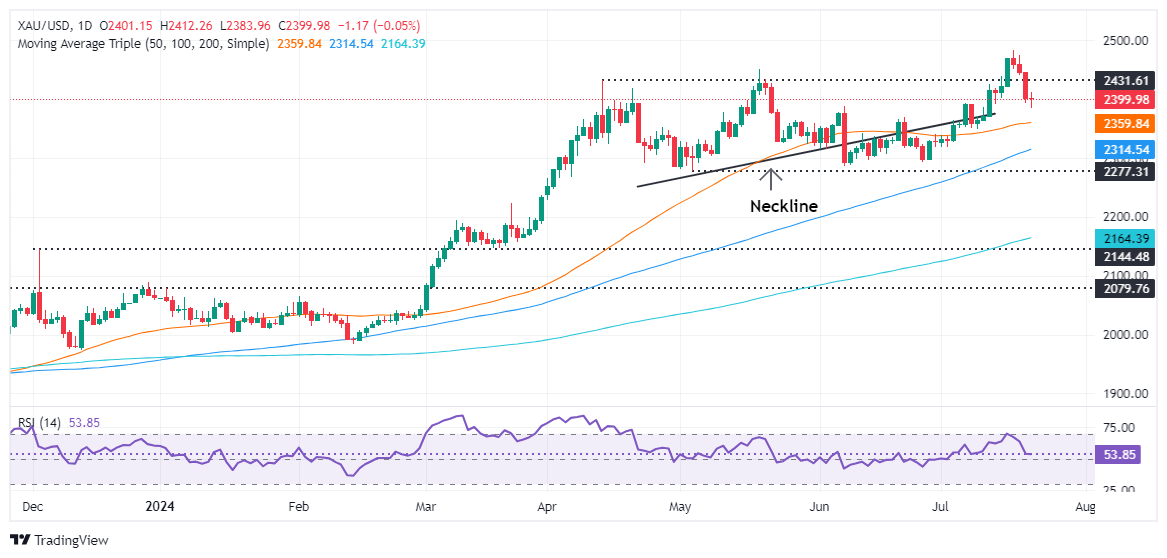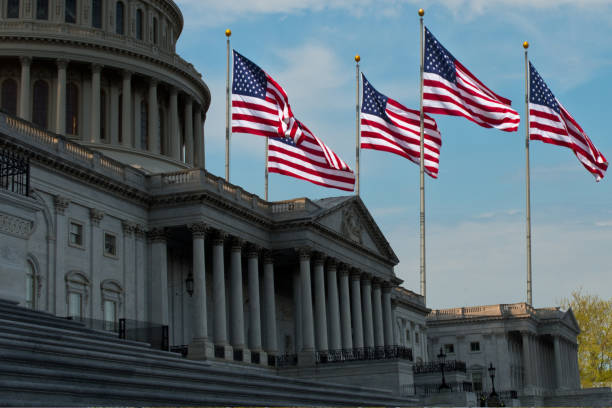- Gold price drops 0.14%, trading at $2,397, influenced by higher US Treasury yields.
- US President Biden exits race and endorses VP Harris, creating political uncertainty and undermining Gold.
- Wall Street opens positively post-Biden’s announcement, US Dollar Index remains steady at 104.34.
Gold price extends its losses for the fourth straight day yet remains hovering around $2,400, capped by rising US Treasury bond yields. The Greenback stays firm as investors diggest news that US President Joe Biden exited the Presidential race and endorsed Vice President Kamala Harris, who would like to compete against former US President Donald Trump in the November 5 elections. The XAU/USD trades at $2,397, down 0.14%.
Wall Street began the week on a positive note, which could be seen as a positive signal after Biden’s decision. Meanwhile, the US 10-year benchmark note coupon edged up two basis points to 4.26%, a headwind for the precious metal.
Analyst at Stone X commented that Trump’s victory would be favorable to Gold due to his tax cuts proposals, less regulation, and a widened budget deficit. "Trump would be inflationary and potentially incendiary in geopolitical terms, while Harris' foreign affairs policy is as yet undefined so that favours gold for now, but not possibly in the longer term."
Meanwhile, traders are eyeing the release of the preliminary reading of Gross Domestic Product (GDP) figures for the second quarter alongside the Federal Reserve’s preferred gauge for inflation, the Core Personal Consumption Expenditure (PCE) Price Index.
The US Dollar Index (DXY), which tracks the currency's performance against six other currencies and is virtually unchanged at 104.34. This has kept Gold prices beneath the $2,400 mark.
Daily digest market movers: Gold price drops beneath key support at $2,400
- Gold traders eye the release of crucial economic data, like Durable Goods Orders, the release of the preliminary Q2 GDP number, and the Core PCE for June.
- Durable Goods Orders are expected to increase from 0.1% to 0.4% MoM
- The Gross Domestic Product for Q2 is foreseen to edge higher from Q1 2024, 1.4% to 1.9% QoQ, hinting the economy is accelerating as the year progresses.
- The Fed’s preferred measure for inflation, the Core PCE is expected to dip from 2.6% to 2.5% YoY.
- The latest Consumer Price Index (CPI) data revealed a continuation of the disinflation process in the United States (US), boosting Gold prices and increasing the likelihood that the Fed will cut interest rates beginning in September.
- December 2024 fed funds rate futures contract implies that the Fed will ease policy by 48 basis points (bps) toward the end of the year, down from 50 last Friday.
Technical analysis: Gold remains defensive, yet appears to have bottomed out
The Gold price extended its losses, pulling back from all-time peaks, yet Monday’s drop was minimal compared to Friday’s loss of more than 1.80%. Momentum favors buyers, as the Relative Strength Index (RSI) stands at bullish territory while also turning flat instead of pointing downwards.
For XAU/USD to extend its losses, sellers must keep spot prices below $2,400. In that event, the first support would be the 50-day Simple Moving Average (SMA) at $2,359. Once sellers clear the 100-day SMA at $2,315, further losses are seen before falling toward $2,300.
Otherwise, if XAU/USD stays above $2,400 and reclaims $2,450, that can pave the way to challenge the all-time high of $2,483 ahead of hitting $2,500.

Fed FAQs
Monetary policy in the US is shaped by the Federal Reserve (Fed). The Fed has two mandates: to achieve price stability and foster full employment. Its primary tool to achieve these goals is by adjusting interest rates. When prices are rising too quickly and inflation is above the Fed’s 2% target, it raises interest rates, increasing borrowing costs throughout the economy. This results in a stronger US Dollar (USD) as it makes the US a more attractive place for international investors to park their money. When inflation falls below 2% or the Unemployment Rate is too high, the Fed may lower interest rates to encourage borrowing, which weighs on the Greenback.
The Federal Reserve (Fed) holds eight policy meetings a year, where the Federal Open Market Committee (FOMC) assesses economic conditions and makes monetary policy decisions. The FOMC is attended by twelve Fed officials – the seven members of the Board of Governors, the president of the Federal Reserve Bank of New York, and four of the remaining eleven regional Reserve Bank presidents, who serve one-year terms on a rotating basis.
In extreme situations, the Federal Reserve may resort to a policy named Quantitative Easing (QE). QE is the process by which the Fed substantially increases the flow of credit in a stuck financial system. It is a non-standard policy measure used during crises or when inflation is extremely low. It was the Fed’s weapon of choice during the Great Financial Crisis in 2008. It involves the Fed printing more Dollars and using them to buy high grade bonds from financial institutions. QE usually weakens the US Dollar.
Quantitative tightening (QT) is the reverse process of QE, whereby the Federal Reserve stops buying bonds from financial institutions and does not reinvest the principal from the bonds it holds maturing, to purchase new bonds. It is usually positive for the value of the US Dollar.








